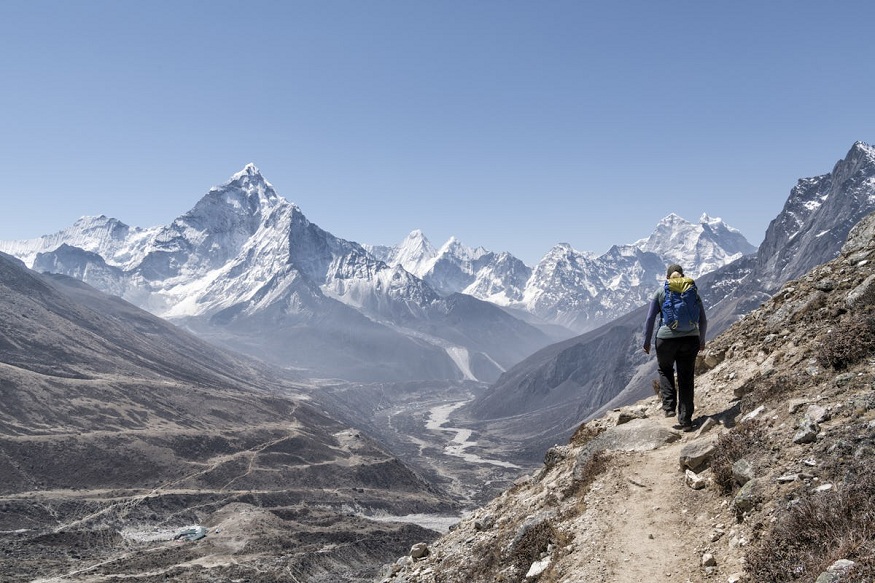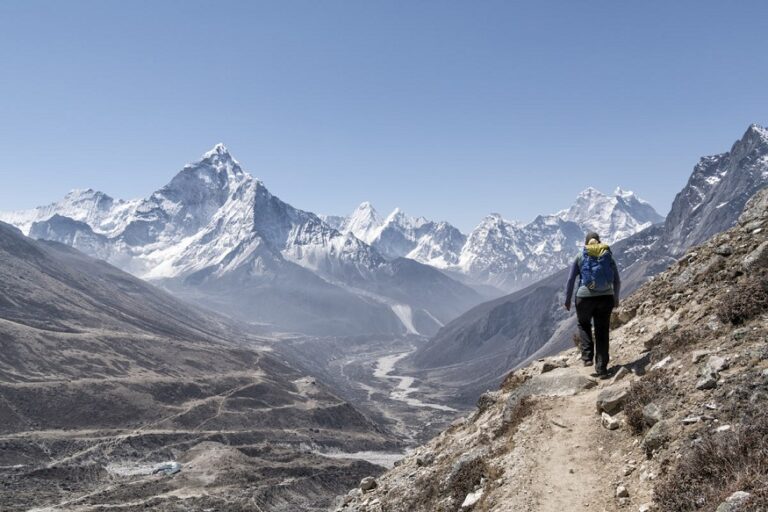Everest Base Camp (EBC) is one of the most famous trekking destinations around the world, attracting trekkers and adventure seekers from every part of the world. Its popularity is easy to understand, offering everything from the world’s highest peak, Mount Everest, to beautiful cultural experiences and breathtaking scenery along the trail — the list goes on.
Trek to Base Camp Mount Everest At the heart of EBC’s appeal is the access it provides to the awe-inspiring Mount Everest. Everest, at 29,032 feet (8,849 meters) tall, is a monument to human endeavor, the site of a famous first ascent in 1953 by Sir Edmund Hillary and Tenzing Norgay. While trekking does not require climbing to the top of the mountain, reaching Everest Base Camp itself puts trekkers at the base of the tallest point on Earth, which is pretty darn cool in and of itself.
The way to EBC walks trekkers through the core of the Himalayas, displaying a great view of the most stunning mountain landscapes in the world. Trekkers passing through the region can gaze at the Himalayan peaks around them, including the towering Lhotse and Nuptse and the iconic Ama Dablam. The varying landscapes, including verdant forests and traditional Sherpa settlements, alpine meadows, and glacial rivers, make the experience all the more rewarding. The diversity of ecosystems and terrain is also appealing, with trekkers crossing bridges over thundering rivers, hiking along ridges with breathtaking views, and encountering various flora and fauna along the way.
But the appeal of the EBC trek is not only physical; it’s also cultural. Throughout the trail, trekkers meet the Sherpa people, whose resourcefulness and expertise in the mountains are renowned. Sherpa villages, including Namche Bazaar, Lukla, and Tengboche, provide glimpses into the region’s rich Buddhist practices and give trekkers opportunities to engage with the local people. Many trekkers find it to be a highlight of their trip to visit the renowned Tengboche Monastery at 12,687 feet (3,867 meters), where those who are interested have the opportunity to observe Buddhist prayer rituals and learn about the religious significance of the Himalayas. Beautiful trekking peaks create a sense of adventure, and the Sherpa people, known for their hospitality and community, make for an environment rich for learning about and connecting with a unique way of life.
EBC’s popularity can also be attributed to the sense of achievement that comes with completing the trek. For many trekkers, the journey to Everest Base Camp represents the end of months of training and preparation, and the realization of standing at the foot of Everest is an incredibly personal victory. The combination of a high-altitude trek, breathtaking views, and cultural richness makes for an experience that’s hard to replicate anywhere else on earth.
EBC’s popularity is also because of its hands-on training. This trek is demanding yet doable for a moderate fit and determined trekker. Unlike some of the more technical climbs, EBC is a trekking route, meaning people don’t need mountaineering skills to access it, so it appeals to a wider audience. Unlike some more remote treks that require numerous camping or hunting skills, this trek offers well-defined trails and teahouses along the route, which provide simple meals and accommodation, making this trek accessible to many trekkers.
To summarize, the appeal of Everest Base Camp lies in the breathtaking natural beauty, cultural experiences, and the challenge of reaching one of the world 39s most famous destinations. The EBC trek is a once-in-a-lifetime adventure, a challenging trek for the views, the people, and simply a chance to engage with culture in the Himalayas, and trekkers keep returning to share their experience.
Welcome: The Appeal of Everest Base Camp
Located at the home of the world’s highest mountain, the Everest Base Camp (EBC) is an irresistible attraction for trekkers and adventure lovers globally. With its unique mix of adventure, natural beauty, and personal accomplishment, the journey to EBC is unlike any other. Perhaps the biggest lure is the chance to see the Himalayas up close — standing at the base, literally, of Mount Everest, the tallest mountain on the planet. Climbing Everest is a pursuit open to only the top of the top in mountaineering, trekking to Base Camp is completely accessible to anyone with an average level of fitness, and the story you have to tell is hard to beat! Along the route, trekkers are steeped in the culture and traditions of the Sherpa people, through dense forests and over high-altitude terrain that is nothing short of awe-inspiring. The breathtaking views, physical challenge, and cultural immersion all contribute to EBC being on many adventurers’ bucket lists around the world.
The Mount Everest View that are Iconic
Everest Base Camp Trek Cost For many trekkers who embark on the journey to Everest Base Camp, one of the main reasons they do so is to see the iconic view of Mount Everest, the tallest mountain in the world. Finally, the transplant — a view from the beaches of the South Island of New Zealand, prints, finally, Nepal — sightseeing, that is, Everest over other peaks. Trekkers get their first view of Everest, Lhotse, Nuptse, and the Khumbu Icefall from different points along the trek, and the views get increasingly better. Viewing these enormous, snow-covered summits standing majestically against the blue sky is so memorable. At Everest Base Camp itself, trekkers have the opportunity to be at 5,364 meters (17,598 feet) and witness the scale and grandeur of the mountain itself. The views of this iconic mountain and the surrounding landscape make the trek even more rewarding. With the view of Mount Everest being one of the main and most significant reasons the EBC trek continues to pull trekkers year after year, countless mountaineering fans and lovers of nature trek to EBC annually.
The Challenge and Sense of Accomplishment
The journey, however, is not a walk in the park; it poses a challenge to your stamina, determination, and your body’s capacity for altitude adjustment. Trekking for days to cover rugged terrain, steep gradients, and changing weather can be a challenge. But the physical challenge of the trek is one of the reasons why reaching EBC is so fulfilling. Hiking at high altitudes where there is less oxygen challenges your endurance and resilience. For most, the journey is where the true motivation lies; the real sense of achievement derives from the struggle and the process of progressing against the odds. The trek provides a good sense of accomplishment as trekkers ascend to higher elevations, cross iconic landmarks such as Namche Bazaar and Tengboche Monastery, and proceed to stand on the base camp itself. For trekkers, reaching Everest Base Camp marks a symbolic milestone, a tangible sign that they have completed an incredible challenge. To be so far away from home with just your carry-on while climbing among beautiful nature is a celebration of how strong and resilient we are as a unit, which makes the victory a truly fulfilling feeling.
Sherpa community: Unique cultural experience
Everest Base Camps The hike to Everest Base Camp is a trip of a lifetime, but is also a unique opportunity for a cultural experience into the life of the Sherpa people who are famous for their mountaineering skills and willingness to support adventurers in climbing some of the highest peaks in the world. The trek passes through several Sherpa villages along the way, including Lukla, Namche Bazaar, and Tengboche, where trekkers are treated to traditional Himalayan hospitality and learn about the cultural wealth of the region. Sherpas have a strong spiritual connection to the mountains, and their lifestyles are heavily influenced by Buddhism. While traveling in the region, visitors will also be able to visit monasteries like the Tengboche Monastery, attend village prayer ceremonies, and meet locals to learn about customs, beliefs, and daily life. The sherpa people are so vital to the success of the Everest expeditions, and their impact on the mountaineering world is more than significant. And, the trek to Everest Base Camp is not just about reaching the pinnacle of a mountain; it also offers a unique cultural experience, where trekkers can immerse themselves in the traditions and customs of the local Sherpa community by trekking through their villages and engaging with them along the way.
Breathtaking views and nature in the Himalayas
Trekking to Everest Base Camp is arguably one of the most beautiful sights on Earth. As they traverse the Khumbu region, trekkers pass through multiple ecosystems, including some lush forests of rhododendron and pine, and rocky, alpine, mostly barren meadows. The route passes through charming villages, cascading waterfalls, and glacial rivers, all framed by towering peaks and dramatic mountain views. Trekking in between, they also get a glimpse of the Khumbu Icefall, one of the Everest region’s most iconic sights, as well as unspoiled glaciers and turquoise alpine lakes. The eye of the imagination is repeatedly captured on varying vistas with each degree of the trail. From crossing high suspension bridges strung over rushing rivers to wandering through alpine forests to the views of majestic peaks like Ama Dablam and Makalu, the scenery on the EBC trek is a reminder of just how magnificent the Himalayas are, and why this trek is so unforgettable.
Access for Trek Lovers of All Levels
The accessibility to trekkers with different fitness levels is among the main reasons hiking to Everest Base Camp (EBC) is so popular. Unlike the intimidating task of actually topping Mount Everest itself, the journey to EBC doesn’t require expert mountaineering abilities. With a reasonable level of fitness and the ability to tolerate all the physical challenges that high-altitude trekking brings, virtually anyone can undertake this journey. The route is straightforward; the slow ascent allows trekkers to acclimatize, reducing the danger of altitude sickness. It is a challenging one, owing to the terrain and the altitude, but its accessibility makes it a dream for anyone hoping to get close to the world’s highest mountain. It can be trekked with a guide or with a porter, making it accessible to both novice and seasoned trekkers.
A Tale Spanning Many Generations and Tied to Mountaineering
The Himalayan Base Camp Trek is known to have a profound significance within the world of mountaineering. EBC has always been the base of many famous climbs since the early expeditions to Everest. In 1953, legendary mountaineers like Sir Edmund Hillary and Tenzing Norgay trekked through this base camp during their quest to reach the mountain’s summit. Their success put the region on the world stage, and the journey to EBC, in the years since, has turned into a pilgrimage of sorts for those with an interest in the history of mountaineering. And to trailpursuers, the beauty of Base Camp lies not only in the physical challenge, for this is a walk in the footsteps of giants. The stories of past expeditions are still echoing through the valleys, and trekkers often feel a connection with the great explorers who have tried to conquer the summit of Everest. The region’s historical backdrop enhances the synergy of respect and awe towards the journey, making it even richer for those who relish mountaineering.
Why It Is So Exciting to Trek in the Footsteps of Legends
Everest Base Camp trek is an exciting adventure and walking in the footsteps of some of the world’s greatest explorers and mountaineers. From the early days of expeditions through to the modern era of mountaineering feats, the path to EBC has seen countless adventures. For trekkers, it is not only the scenery that matters, but the thrill and the story of walking on the same trail as the best heroes in climbing. It’s liberating to walk in their footsteps, to conquer the same obstacles they had to face, and to arrive at Base Camp where many of the most renowned expeditions set off from. While the trail rewards visitors with stunning natural beauty, it also gives them a personal connection to the storied legacy of Everest and those who have made history trying to reach its summit.
Increasing Interest Among Tourists and Adventurers
Since then, the Everest base camp has gained immense popularity as a trekking destination, with thousands of visitors arriving each year to experience this iconic journey. The natural methodology of the trek is largely responsible for its success, and the growing appeal of adventure travel, coupled with trekking in remote, high-altitude regions, is contributing to its popularity. Social media also played a part; intrepid explorers document their expeditions, inspiring others to do the same. This has led to a lot of infrastructure being developed along the trail, including better trekking routes, teahouses, and accommodations. The rising number of tourists has made EBC not just more visible but also profitable for local communities. Although the trek is still very difficult and isolated, the rise in the number of trekkers has led to increased support, making the experience easier and more enjoyable for all. Despite its recent boost in popularity, the journey is still a once-in-a-lifetime experience, luring trekkers and adventurers from far and wide.
Experiences of Contemplation and Spirituality on the Trail
Mount Everest Base Camp Trek is not only about physicality and adventure; for many trekkers, it is a spiritual journey with plenty of time for reflection. As trekkers make their way through the Khumbu region, they pass by Buddhist stupas, prayer wheels, and monasteries, all of which instill a sense of peace and connection to the surroundings. As the trekker goes up to higher altitudes and looks at the vastness of the surrounding mountains, many report a sense of calm and reflection. The Sherpa people are deeply spiritual, and their connection to the Himalayas only enhances the ethereal quality of the trek; many trekkers take the time to meditate, pray, or simply reflect on their journey. With breathtaking vistas of Everest and other summits, the environment is almost meditative, inspiring reflection and reverence for the natural world. This journey not only brings you more in touch with who you are, but also with the breathtaking beauty of the Himalayas all around you.
Why is Everest Base Camp Famous?
Everest Base Camp (EBC) is so famous because it is a great starting point for a climb to Mount Everest, the highest mountain in the world. The iconic trek is on the bucket lists of trekkers from around the globe, as it provides some of the best views of Everest and its neighboring peaks in the Himalayas. The camp also has historical significance since it has been the base for many iconic climbing expeditions, including Sir Edmund Hillary and Tenzing Norgay’s pioneering climb in 1953. The hike to EBC also offers a chance to immerse yourself in the Sherpa culture, as well as face the challenge of high-altitude trekking, all of which are a blend of adventure, history, and cultural experience. As the trend gains momentum, 804 has evolved as the epitome of conquering the millennial class, rising to the top of life challenges , and from a trend, obtaining to be a lifestyle for outdoor lovers.
Why Do People Just Go to Everest Base Camp?
Mount Everest Base Camp Trek Many hikers make the trek to Everest Base Camp (EBC) because it offers a physical connection to the world’s tallest mountain without the extreme danger of climbing it. The trek to EBC provides you with the chance to see breathtaking views of Mount Everest and other magnificent mountains and interact with the unique culture of the Sherpa people. For many of us, the experience of getting to Base Camp represents a goal achieved, and one that does not require advanced mountaineering expertise. The hike is open to all fitness levels and is a favorite of trekkers who wish to experience the majesty of the Himalayas without requiring the extreme altitude of a summit. For many adventurers climbing the route, even if they never plan to reach Everest itself, the physical challenge and opportunity to be in one of the most beautiful places on the planet will be enough.
What Makes Mount Everest So Popular?
The popularity of climbing Mount Everest stems from its being the world’s tallest mountain, but also the appeal of safely reaching the summit. It is the ultimate challenge for mountaineers and has been the aim of explorers for more than a century. The towering height and treacherous conditions lure climbers, trekkers, adventurers, and nature lovers from all over the world. Everest is the name that symbolises adventure, endurance, and human will. This isn’t just a mountain, this is an icon. Whether dreamers or adrenalin junkies, the idea of conquering Everest, by summiting it or trekking to Base Camp, is a catch-all for people from different walks of life. For those who can’t reach the summit, the Everest Base Camp trek provides a different way to experience the mountain’s majesty. The storied history of successes and failures, paired with the daunting configuration of the environment, makes Everest a remarkable piece of natural earth, and one of the most popular pieces at that.
Which Everest Base Camp is More Popular?
Everest Base Camp Treks We will be doing the Classic Everest Base Camp Trek, the most popular trek in the area, which starts in Lukla. This is a common route trekkers take the most as it is the most accessible and there is are best supporting infrastructure available with great views. Beginning in Lukla, trekkers navigate villages like Namche Bazaar, Tengboche , and Dingboche, which all provide their adventures, views, and acclimatization options. This trek allows trekkers to interact with the region’s culture, its magnificent surroundings, and, indeed, the breathtaking view of Mount Everest. Other options would include the Jiri or Gokyo Lakes trek as alternatives, but the Lukla-based route is the most used option as it is very convenient, has lots of tourist infrastructure, and goes directly to Base Camp.

















+ There are no comments
Add yours